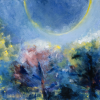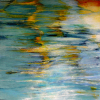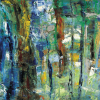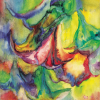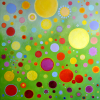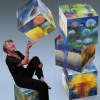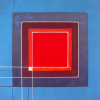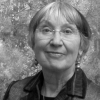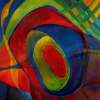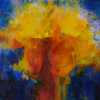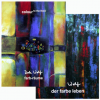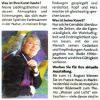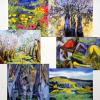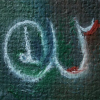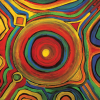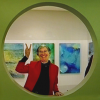Dorle Wolf’s compositions inspired by nature, which connect colour and light to imaginary spaces and extend from atmospheric lightness to powerful expressions of colour, are also always landscapes of the soul; landscapes, which have a vocabulary of colourful melody - landscapes from the soul, which with their peaceful or expressive structures - be they flooded with light or shadowy, translucent or mysterious - reflect inner worlds.
… Dorle Wolf’s fully abstract “light-lines” lend rhythm to the composition and give it more severe structures. But also, because of the distinctive incidences of light, all the surrounding colours seem to be illuminated from behind or inside. That heightens the poetry, the transcendency, the mythical and the reflective, not only of the detail, but of the whole atmosphere of a picture.
It seems to me that it is only the vocabulary of music which can reach Dorle Wolf’s "Compositions". Her radiant instrumentation, her colour tones and rhythms form a link with the elemental experiences of the soul. In her latest pictures she conjures up a sparkling, moving structure of Dionysian festiveness and paces out emotional areas which, in defiance of reason, we have within us.
Dr. Eva-Suzanne Bayer, art historian (Würzburg)
As many pictures and sequences of pictures reveal, music is an important source of inspiration for Dorle Wolf … Sometimes, however, she goes far beyond poetry and composition, seeks out the spiritual content of both and gives responses in colour to what music and words evoke in her. She does not illustrate, she completes and synthesizes the different arts.
Liane Thau, M.A., art historian
This way of producing the illusion of spatial depth rests then solely on the wavelength of the pigment used, in other words, on the colour’s very own property … I also find in that an attitude which I would designate post-modern. If in modern art the creation of any illusion on the surface has been condemned, and concentration has been completely on the "real means" of painting such as colour, surface and line, then here again the illusion of spatial depth has been created by one of these means: by colour, and solely from its own physical conditions ... not a depth which is firmly established, but a peculiarly floating, virtual impression of depth.
Stephanie Huber, sculptress


